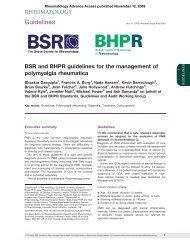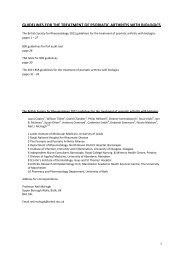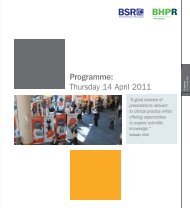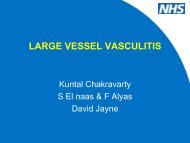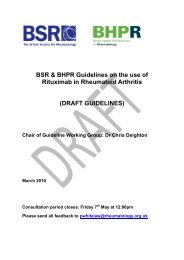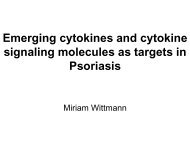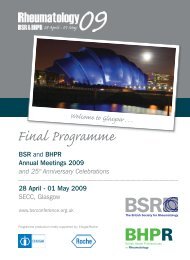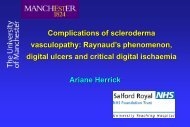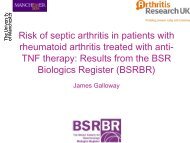Lung and pulmonary vascular disease in scleroderma, the role of ...
Lung and pulmonary vascular disease in scleroderma, the role of ...
Lung and pulmonary vascular disease in scleroderma, the role of ...
You also want an ePaper? Increase the reach of your titles
YUMPU automatically turns print PDFs into web optimized ePapers that Google loves.
<strong>Lung</strong> <strong>and</strong> Pulmonary Vascular<br />
<strong>disease</strong> <strong>in</strong> Systemic Sclerosis – <strong>the</strong><br />
<strong>role</strong> <strong>of</strong> <strong>the</strong> Respiratory Physician<br />
Jay Suntharal<strong>in</strong>gam<br />
Consultant Respiratory Physician<br />
Royal United Hospital, Bath
Frequency (%)<br />
Steen VD <strong>and</strong> Medsger TA. Ann Rheum Dis 2007; 66:940-4.<br />
The chang<strong>in</strong>g face <strong>of</strong> <strong>scleroderma</strong><br />
50<br />
40<br />
Scleroderma renal crisis<br />
PAH<br />
Interstitial lung <strong>disease</strong><br />
30<br />
p
Overview<br />
• Respiratory <strong>disease</strong>s <strong>in</strong> CTD<br />
• Systemic sclerosis <strong>and</strong> <strong>the</strong> lungs<br />
• Interstitial <strong>Lung</strong> Disease (ILD)<br />
• Pulmonary Hypertension (PH)
Localis<strong>in</strong>g respiratory <strong>disease</strong>s<br />
Airways <strong>disease</strong><br />
Chest wall <strong>disease</strong><br />
Vascular <strong>disease</strong><br />
Parenchymal lung <strong>disease</strong>
Respiratory causes <strong>of</strong> dyspnoea<br />
<strong>in</strong> CTD<br />
Airways Pleura PAH Muscle ILD Sk<strong>in</strong><br />
SSc -/+ -/+ +++ - +++++ ++<br />
RA +++++ +++ -/+ - ++<br />
PM/DM -/+ - -/+ ++ ++++<br />
Sjogrens +++++ -/+ + -/+ +++<br />
SLE -/+ ++++ ++ + +<br />
Plus……<br />
- aspiration pneumonitis<br />
- atypical <strong>in</strong>fections<br />
- drug <strong>in</strong>duced lung <strong>disease</strong><br />
- co-existent lung <strong>disease</strong>
Overview<br />
• Respiratory <strong>disease</strong>s <strong>in</strong> CTD<br />
• Systemic sclerosis <strong>and</strong> <strong>the</strong> lungs<br />
• Interstitial <strong>Lung</strong> Disease (ILD)<br />
• Pulmonary Hypertension (PH)
Serological subsets <strong>in</strong> <strong>scleroderma</strong><br />
Diffuse sk<strong>in</strong><br />
<strong>disease</strong><br />
<strong>Lung</strong><br />
Topo-I<br />
RNAP II0<br />
RNAP<br />
Kidney<br />
U3RNP<br />
U1RNP<br />
Centromere<br />
PH<br />
Th RNP<br />
Pm-Scl<br />
<strong>Lung</strong><br />
Limited sk<strong>in</strong><br />
<strong>disease</strong><br />
Overlap features<br />
Courtesy <strong>of</strong><br />
Pr<strong>of</strong> Neil McHugh
Overview<br />
• Respiratory <strong>disease</strong>s <strong>in</strong> CTD<br />
• Systemic sclerosis <strong>and</strong> <strong>the</strong> lungs<br />
• Interstitial <strong>Lung</strong> Disease (ILD)<br />
• Pulmonary Hypertension (PH)
Interstitial lung <strong>disease</strong>
Histological patterns <strong>in</strong> ILD<br />
• UIP<br />
• NSIP<br />
• OP<br />
• DIP<br />
• LIP<br />
• RB-ILD<br />
• DAD<br />
Bjoraker, et al. Am J Respir Crit Care Med 1998;157:199
Non Specific Interstitial Pneumonitis<br />
(NSIP)
Pathogenesis<br />
GORD 1 ?<br />
1<br />
Christmann et al. Sem<strong>in</strong> Arthritis Rheum 2010; 40(3):241-9
ILD – <strong>role</strong> <strong>of</strong> <strong>the</strong> Respiratory Physician<br />
• identify<strong>in</strong>g patients with SSc-ILD
SSc-ILD – cl<strong>in</strong>ical presentation<br />
• Often asymptomatic <strong>in</strong> early stages<br />
• Insidious onset exertional dyspnoea<br />
• Dry cough<br />
• Exam<strong>in</strong>ation<br />
– bilateral f<strong>in</strong>e crackles
<strong>Lung</strong> function test<strong>in</strong>g<br />
• Volumes (ie FEV1, FVC, FER)<br />
• Diffusion coefficient (ie TLCO & KCO)
Spirometry<br />
FEV1<br />
FVC<br />
FVR<br />
forced expiratory volume <strong>in</strong> 1 second<br />
forced vital capacity<br />
FEV1/FVC - forced expiratory ratio<br />
Volume<br />
(L)<br />
FVC<br />
FEV1<br />
1 2 3 4<br />
5<br />
Time (sec)
Spirometry<br />
1) Obstructive defect<br />
• FEV1/FVC ratio 70%<br />
• e.g. <strong>in</strong>terstitial lung <strong>disease</strong><br />
chest wall <strong>disease</strong><br />
1 sec 3 4 5 T
TLCO <strong>and</strong> KCO<br />
• TLCO reflects pathology<br />
at <strong>the</strong> alveolar-capillary<br />
<strong>in</strong>terface<br />
• Reduced <strong>in</strong> eg<br />
– ILD<br />
– PH
<strong>Lung</strong> function patterns<br />
SSc-ILD SSc-PH Extrathoracic Airways<br />
FEV1 Reduced Normal Reduced Reduced<br />
FVC Reduced Normal Reduced Normal<br />
FEV1/FVC Restrictive Normal Restrictive Obstructive<br />
TLCO Reduced Reduced Reduced Normal<br />
KCO Reduced Reduced Normal Normal
CXR<br />
• CXR <strong>in</strong>sensitive for detect<strong>in</strong>g ILD<br />
– 35% detection rate vs 91% for HRCT<br />
Schurawitzki et al, Radiology 1990;176:755-9
HRCT<br />
• Very sensitive<br />
• Allows subtyp<strong>in</strong>g<br />
• Allows quantification <strong>of</strong> <strong>disease</strong> severity<br />
• Excludes o<strong>the</strong>r <strong>disease</strong>s eg atypical<br />
<strong>in</strong>fection, drug <strong>in</strong>duced lung <strong>disease</strong>
ILD – <strong>role</strong> <strong>of</strong> <strong>the</strong> Respiratory Physician<br />
• identify<strong>in</strong>g patients<br />
• assess<strong>in</strong>g severity
HRCT extent<br />
20%<br />
FVC>70%<br />
FVC
ILD – <strong>role</strong> <strong>of</strong> <strong>the</strong> Respiratory Physician<br />
• identify<strong>in</strong>g patients<br />
• assess<strong>in</strong>g severity<br />
• <strong>in</strong>itiat<strong>in</strong>g treatment
Management<br />
• Supportive<br />
– Multidiscipl<strong>in</strong>ary approach<br />
– Treat GORD if appropriate<br />
– Domiciliary oxygen<br />
• Specific treatment<br />
– FAST study – iv CYC + AZA/prednisolone<br />
– SLS study – oral CYC<br />
Hoyles et al Arthritis & Rheumatism 2006; 54(12):3962-70<br />
Tashk<strong>in</strong> et al NEJM 2006;354:2655-66
Our local practice<br />
• Non-progressive limited <strong>disease</strong><br />
– observation<br />
• Slowly progressive <strong>disease</strong><br />
– pred/AZA<br />
– MMF if <strong>in</strong>tolerant <strong>of</strong>/progresses on AZA<br />
• Rapidly progressive <strong>disease</strong><br />
– pred/pulsed CYC followed by pred/AZA<br />
– MMF if <strong>in</strong>tolerant <strong>of</strong>/progresses on AZA
Overview<br />
• Respiratory <strong>disease</strong>s <strong>in</strong> CTD<br />
• Systemic sclerosis <strong>and</strong> <strong>the</strong> lungs<br />
• Interstitial <strong>Lung</strong> Disease (ILD)<br />
• Pulmonary Hypertension (PH)
Pulmonary hypertension
PH – a syndrome<br />
1. Pulmonary Arterial Hypertension<br />
- Idiopathic PAH (IPAH)<br />
- Heritable<br />
- Drugs/tox<strong>in</strong>s<br />
- Associated PAH (APAH)<br />
connective tissue <strong>disease</strong>s<br />
HIV <strong>in</strong>fection<br />
portal hypertension<br />
congenital heart <strong>disease</strong>s<br />
1*. PVOD/PCH<br />
2. PH 2ry to left heart <strong>disease</strong><br />
- systolic <strong>and</strong> diastolic dysfunction<br />
- valvular<br />
3. PH 2ry to lung <strong>disease</strong><br />
- COPD<br />
- <strong>in</strong>terstitial lung <strong>disease</strong><br />
- sleep disordered breath<strong>in</strong>g<br />
- developmental abnormalities<br />
4. PH due to chronic thrombotic<br />
<strong>and</strong>/or embolic <strong>disease</strong><br />
- proximal CTEPH<br />
- distal CTEPH<br />
- non-thrombotic embolism<br />
5. Miscellaneous<br />
- sarcoid<br />
- PLCH, LAM<br />
- metabolic disorders<br />
Adapted from Dana Po<strong>in</strong>t Classification 2008
Classification <strong>of</strong> PH<br />
1. Pulmonary Arterial<br />
Hypertension (PAH)<br />
3. PH secondary to<br />
respiratory <strong>disease</strong><br />
2. PH secondary to left<br />
heart <strong>disease</strong><br />
4. CTEPH
PH – <strong>role</strong> <strong>of</strong> <strong>the</strong> Respiratory Physician<br />
• identify<strong>in</strong>g patients with PH
<strong>Lung</strong> function as a screen<strong>in</strong>g tool?<br />
Mukerjee et al, Rheumatology 2004;43,461-66
Echo as a screen<strong>in</strong>g tool?<br />
PASP = 4 v 2 + RA Pressure<br />
(Simplified Bernoulli Equation)<br />
PASP>40mmHg suggests PH 1<br />
(ie TG~3m/sec)<br />
1<br />
Mukerjee et al, Rheumatology 2004;43,461-66
Trans-Tricuspid<br />
pressure difference<br />
(echo) (mmHg)<br />
1. Gibbs JSR. Eur Respir Rev 2007; 16:8-12.<br />
2. Mukerjee D, et al. Rheumatology 2004;43:461-6.<br />
Limitations <strong>of</strong> echocardiography<br />
100<br />
80<br />
60<br />
40<br />
False<br />
positive<br />
r 2 =0.4515<br />
20<br />
0<br />
0 20 40 60<br />
25<br />
False negative<br />
mPAP (mmHg) measured <strong>in</strong>vasively (RHC)<br />
80
PAH screen<strong>in</strong>g algorithm at Royal Free<br />
SSc annual review<br />
<strong>Lung</strong> function<br />
Echo<br />
Questionnaire<br />
TG < 2.5 m/s<br />
DLCO > 55%<br />
No unexpla<strong>in</strong>ed dyspnoea<br />
No o<strong>the</strong>r cardiac problems<br />
Courtesy <strong>of</strong> Pr<strong>of</strong> Denton, Royal Free<br />
TG > 3 m/s<br />
TLCO < 55% + TLC > 80%<br />
or<br />
TG > 2.5 + any dyspnoea<br />
20% fall <strong>in</strong> DLCO<br />
or<br />
New dyspnoea<br />
O<strong>the</strong>r cardiac problem<br />
Cardiac ca<strong>the</strong>terisation
PH – <strong>role</strong> <strong>of</strong> <strong>the</strong> Respiratory Physician<br />
• identify<strong>in</strong>g patients with PH<br />
• dist<strong>in</strong>guish<strong>in</strong>g SSc-PAH from o<strong>the</strong>r forms<br />
<strong>of</strong> PH
PH – a syndrome<br />
1. Pulmonary Arterial Hypertension<br />
- Idiopathic PAH (IPAH)<br />
- Heritable<br />
- Drugs/tox<strong>in</strong>s<br />
- Associated PAH (APAH)<br />
connective tissue <strong>disease</strong>s<br />
HIV <strong>in</strong>fection<br />
portal hypertension<br />
congenital heart <strong>disease</strong>s<br />
1*. PVOD/PCH<br />
2. PH 2ry to left heart <strong>disease</strong><br />
- systolic <strong>and</strong> diastolic dysfunction<br />
- valvular<br />
3. PH 2ry to lung <strong>disease</strong><br />
- COPD<br />
- <strong>in</strong>terstitial lung <strong>disease</strong><br />
- sleep disordered breath<strong>in</strong>g<br />
- developmental abnormalities<br />
4. PH due to chronic thrombotic<br />
<strong>and</strong>/or embolic <strong>disease</strong><br />
- proximal CTEPH<br />
- distal CTEPH<br />
- non-thrombotic embolism<br />
5. Miscellaneous<br />
- sarcoid<br />
- PLCH, LAM<br />
- metabolic disorders<br />
Adapted from Dana Po<strong>in</strong>t Classification 2008
PH – <strong>role</strong> <strong>of</strong> <strong>the</strong> Respiratory Physician<br />
• identify<strong>in</strong>g patients with PH<br />
• dist<strong>in</strong>guish<strong>in</strong>g SSc-PAH from o<strong>the</strong>r forms<br />
<strong>of</strong> PH<br />
• <strong>in</strong>itiat<strong>in</strong>g <strong>the</strong>rapy
Take home po<strong>in</strong>ts<br />
• SSc can be associated with a number <strong>of</strong><br />
respiratory disorders<br />
• The presence <strong>of</strong> SSc-ILD <strong>and</strong>/or SSc-PAH<br />
can <strong>in</strong>crease morbidity <strong>and</strong> mortality<br />
significantly<br />
• SSc patients should be screened for both<br />
<strong>disease</strong>s – but beware <strong>of</strong> <strong>the</strong> potential<br />
pitfalls




